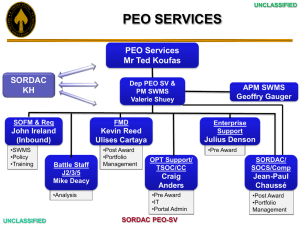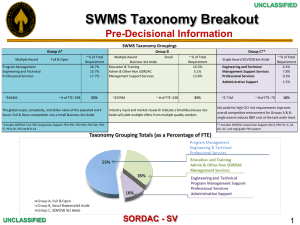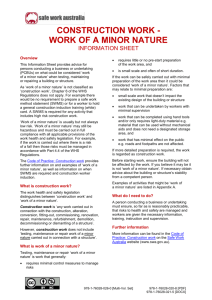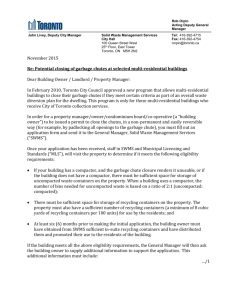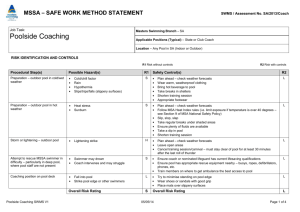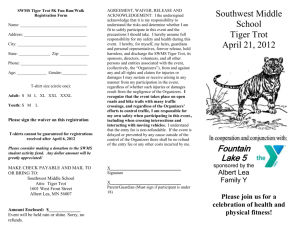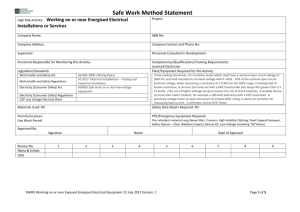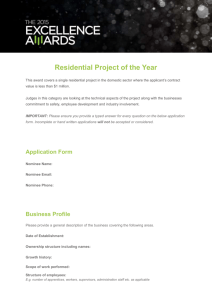What is a SWMS? - Safe Work Australia
advertisement
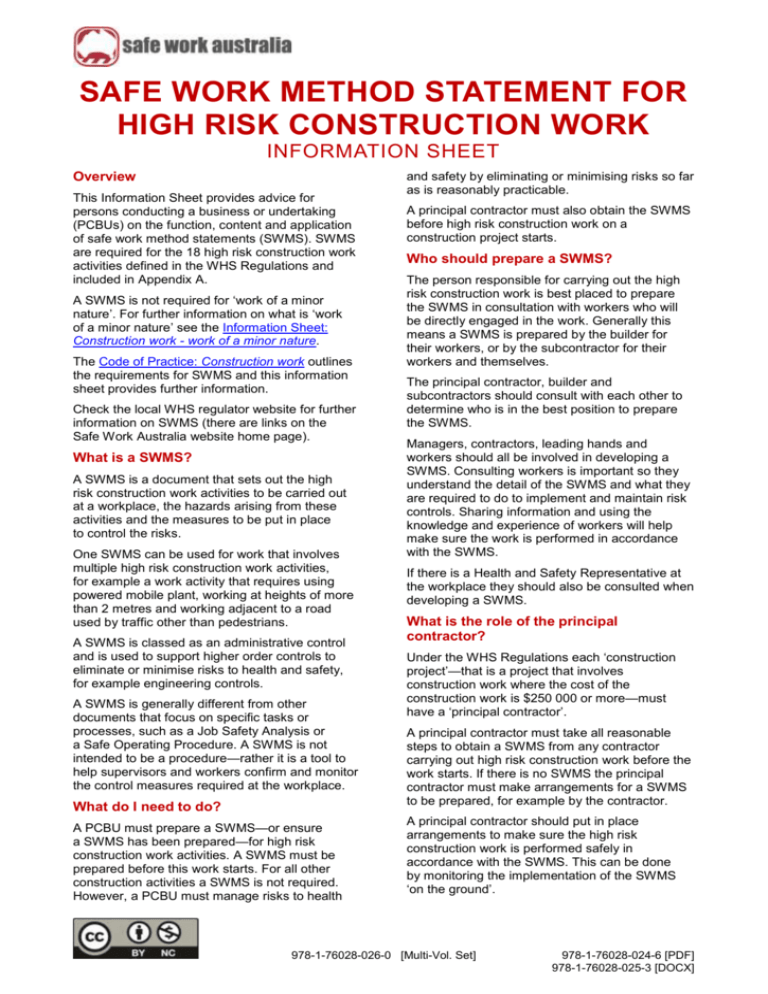
SAFE WORK METHOD STATEMENT FOR HIGH RISK CONSTRUCTION WORK INFORMATION SHEET Overview This Information Sheet provides advice for persons conducting a business or undertaking (PCBUs) on the function, content and application of safe work method statements (SWMS). SWMS are required for the 18 high risk construction work activities defined in the WHS Regulations and included in Appendix A. A SWMS is not required for ‘work of a minor nature’. For further information on what is ‘work of a minor nature’ see the Information Sheet: Construction work - work of a minor nature. The Code of Practice: Construction work outlines the requirements for SWMS and this information sheet provides further information. Check the local WHS regulator website for further information on SWMS (there are links on the Safe Work Australia website home page). What is a SWMS? A SWMS is a document that sets out the high risk construction work activities to be carried out at a workplace, the hazards arising from these activities and the measures to be put in place to control the risks. One SWMS can be used for work that involves multiple high risk construction work activities, for example a work activity that requires using powered mobile plant, working at heights of more than 2 metres and working adjacent to a road used by traffic other than pedestrians. A SWMS is classed as an administrative control and is used to support higher order controls to eliminate or minimise risks to health and safety, for example engineering controls. A SWMS is generally different from other documents that focus on specific tasks or processes, such as a Job Safety Analysis or a Safe Operating Procedure. A SWMS is not intended to be a procedure—rather it is a tool to help supervisors and workers confirm and monitor the control measures required at the workplace. What do I need to do? A PCBU must prepare a SWMS—or ensure a SWMS has been prepared—for high risk construction work activities. A SWMS must be prepared before this work starts. For all other construction activities a SWMS is not required. However, a PCBU must manage risks to health and safety by eliminating or minimising risks so far as is reasonably practicable. A principal contractor must also obtain the SWMS before high risk construction work on a construction project starts. Who should prepare a SWMS? The person responsible for carrying out the high risk construction work is best placed to prepare the SWMS in consultation with workers who will be directly engaged in the work. Generally this means a SWMS is prepared by the builder for their workers, or by the subcontractor for their workers and themselves. The principal contractor, builder and subcontractors should consult with each other to determine who is in the best position to prepare the SWMS. Managers, contractors, leading hands and workers should all be involved in developing a SWMS. Consulting workers is important so they understand the detail of the SWMS and what they are required to do to implement and maintain risk controls. Sharing information and using the knowledge and experience of workers will help make sure the work is performed in accordance with the SWMS. If there is a Health and Safety Representative at the workplace they should also be consulted when developing a SWMS. What is the role of the principal contractor? Under the WHS Regulations each ‘construction project’—that is a project that involves construction work where the cost of the construction work is $250 000 or more—must have a ‘principal contractor’. A principal contractor must take all reasonable steps to obtain a SWMS from any contractor carrying out high risk construction work before the work starts. If there is no SWMS the principal contractor must make arrangements for a SWMS to be prepared, for example by the contractor. A principal contractor should put in place arrangements to make sure the high risk construction work is performed safely in accordance with the SWMS. This can be done by monitoring the implementation of the SWMS ‘on the ground’. 978-1-76028-026-0 [Multi-Vol. Set] 978-1-76028-024-6 [PDF] 978-1-76028-025-3 [DOCX] The WHS Regulations require that the principal contractors’ WHS management plan includes specific arrangements for collecting, assessing, monitoring and reviewing the SWMS. What information must be included in a SWMS? A SWMS must: identify the work that is high risk construction work specify hazards relating to the high risk construction work and the risks to health and safety describe the measures to be implemented to control the risks, and describe how the control measures are to be implemented, monitored and reviewed. A SWMS should be short and focus on describing the specific hazards identified for the high risk construction work to be undertaken and the control measures to be put in place so the work is carried out safely (see Appendix A). A lengthy, overly detailed SWMS can be difficult to understand, apply at the workplace, monitor or review. A SWMS must be easily understood by workers, including those from non-English speaking backgrounds. For example, pictures or diagrams may be a more effective way of communicating information. While there are other legislative requirements to ensure health and safety—for example to control exposure to noise and manual task hazards— these hazards and risk controls do not need to be included in a SWMS. If the SWMS is based on a workplace-specific risk assessment, evidence of the risk assessment may be required by the regulator or for auditing purposes but does not need to be detailed in the SWMS. SWMS template A SWMS template is provided at Appendix A. This template outlines the information which must be included in a SWMS. The template also includes other information which should be included as best practice, for example who was consulted to prepare the SWMS. However, when adding more information to the SWMS consider the importance and relevance of the information and whether it will add unnecessary length or complexity to the document. Information sheet: Safe Work Statement High Risk Construction Work Can a generic SWMS be used? It is important for a SWMS to reflect the specific circumstances of the workplace in which it will operate—that is the workplace where the high risk construction work is to be carried out, the work environment and the workers carrying out the work. A generic SWMS used at different workplaces may not meet the requirements of the WHS laws unless it has first been reviewed to take into account the hazards and risks at the specific workplace and amended as necessary. One SWMS can be prepared to cover a variety of tasks if it takes into account the changing nature of the work environment. Alternatively, a separate SWMS can be prepared for each high risk construction work activity. In this case consider situations where different activities impact each other, for example using powered mobile plant during the construction of a tunnel. Implementing and reviewing a SWMS High risk construction work must be carried out in accordance with the SWMS. The PCBU must put in place arrangements to ensure the SWMS is being complied with, for example workplace visits. If work is not being carried out in accordance with the SWMS then it must stop immediately or as soon as it is safe to do so. In these cases the SWMS should be reviewed and if necessary revised to reflect the safest way to carry out the work that is reasonably practicable. Work must not resume until the work can be carried out in accordance with the SWMS. A PCBU must also ensure a SWMS is reviewed and as necessary revised if the measures put in place to control risks to health and safety are revised. Where do I keep a SWMS? The SWMS should be kept at the workplace where the high risk construction work will be carried out. If this is not possible then a SWMS should be kept at a location where it can be delivered to the workplace quickly. A SWMS can also be kept electronically. Further information More information can be found in the Code of Practice: Construction work on the Safe Work Australia website (www.swa.gov.au). December 2014 Page 2 of 4 APPENDIX A - HIGH RISK CONSTRUCTION WORK SAFE WORK METHOD STATEMENT TEMPLATE NOTE: Work must be performed in accordance with this SWMS. This SWMS must be kept and be available for inspection until the high risk construction work to which this SWMS relates is completed. If the SWMS is revised, all versions should be kept. If a notifiable incident occurs in relation to the high risk construction work in this SWMS, the SWMS must be kept for at least 2 years from the date of the notifiable incident. [PCBU Name, contact details] Principal Contractor (PC) Works Manager: Date SWMS provided to PC: Contact phone: [Name, contact details] Work activity: [Job description] High risk construction work: Risk of a person falling more than 2 metres (Note: in some jurisdictions this is 3 metres) Work on a telecommunication tower Demolition of load-bearing structure Likely to involve disturbing asbestos Temporary load-bearing support for structural alterations or repairs Work in or near a confined space Work in or near a shaft or trench deeper than 1.5 m or a tunnel Use of explosives Work on or near pressurised gas mains or piping Work on or near chemical, fuel or refrigerant lines Work on or near energised electrical installations or services Work in an area that may have a contaminated or flammable atmosphere Tilt-up or precast concrete elements Work on, in or adjacent to a road, railway, shipping lane or other traffic corridor in use by traffic other than pedestrians Work in an area with movement of powered mobile plant Work in areas with artificial extremes of temperature Work in or near water or other liquid that involves a risk of drowning Diving work Workplace location: Person responsible for ensuring compliance with SWMS: Date SWMS received: What measures are in place to ensure compliance with the SWMS? Person responsible for reviewing SWMS control measures: Date SWMS received by reviewer: How will the SWMS control measures be reviewed? Reviewer’s signature: Review date: Information sheet: Safe Work Statement High Risk Construction Work December 2014 Page 3 of 4 What are the tasks involved? What are the hazards and risks? What are the control measures? List the work tasks in a logical order. Identify the hazards and risks that may cause harm to workers or the public. Describe what will be done to control the risk. What will you do to make the activity as safe as possible? Name of Worker(s) Worker signature(s) Date SWMS received by workers: Information sheet: Safe Work Statement High Risk Construction Work December 2014 Page 4 of 4
